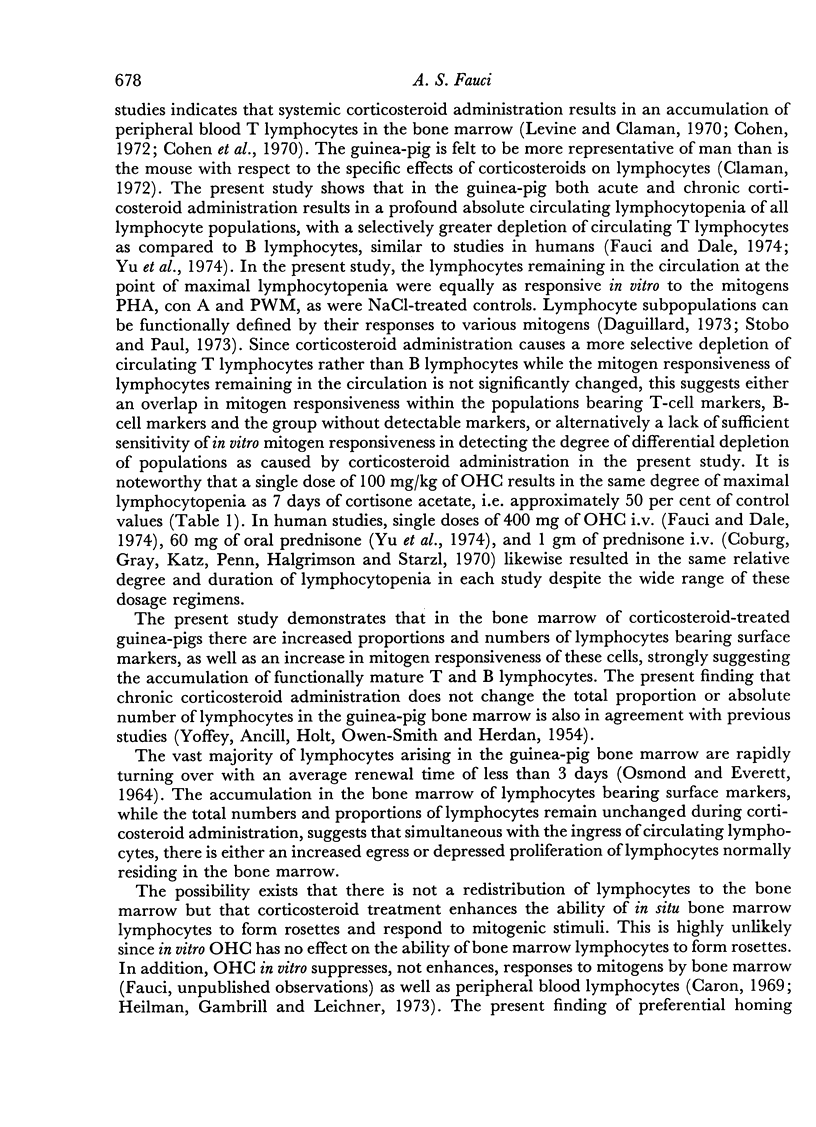Abstract
The effect of corticosteroid administration on the redistribution of sirculating lymphocytes was studied in the guinea-pig, since this species closely resembles man in its relative resistance to the lymphopenic effect of corticosteroids. A single intravenous injection of hydrocortisone (either 10 mg or 100 mg/kg) caused a profound but transient lymphocytopenia which was maximal at 4 hours following injection, with a returnto normal counts by 24 hours. There was a proportionately greater decrease in circulating T lymphocytes compared to B lymphocytes, although both populations were diminished. Chronic cortisone acetate treatment (100 mg/kg subcutaneously for 7 days) caused a similiar pattern of lymphocytopenia except that it was sustained during the period of chronically elevated plasma cortisol levels. The lymphocytes remaining inthe circulation during the period of lymphocytopenia responded normally in vitro to the mitogens phytohemagglutinin, concanavalin A, and pokeweek mitogen. There was very littleeffect of corticosteroid administration on the numbers, proportions, or mitogenic response of splenic lymphocytes. There was a dramatic increase in the bone marrow of proportions and absolute numbers of lymphocytes bearing surface T-and B-cell markers, as well as a marked increase in response of bone marrow lymphocytes to mitogenic stimulation during the period of maximal circulating lymphocytopenia caused by the administration of corticosteroids, especially chronic cortisone acetate. There was a preferential homing of reinfused -51Cr-labelled syngeneic peripheral blood lymphocytes to the bone marrow of corticosteroid-treated recipients. These studies demonstrate aredistribution of circulating lymphocytes to the bone marrow during corticosteroid treatment, resulting in an increase in immunocompetence of this compartment, while the peripheral blood lymphocyte compartment is quantitatively immunosuppressed due to a lymphocytopenia.
Full text
PDF











Selected References
These references are in PubMed. This may not be the complete list of references from this article.
- Bianco C., Patrick R., Nussenzweig V. A population of lymphocytes bearing a membrane receptor for antigen-antibody-complement complexes. I. Separation and characterization. J Exp Med. 1970 Oct 1;132(4):702–720. doi: 10.1084/jem.132.4.702. [DOI] [PMC free article] [PubMed] [Google Scholar]
- Böyum A. Isolation of mononuclear cells and granulocytes from human blood. Isolation of monuclear cells by one centrifugation, and of granulocytes by combining centrifugation and sedimentation at 1 g. Scand J Clin Lab Invest Suppl. 1968;97:77–89. [PubMed] [Google Scholar]
- Claman H. N. Corticosteroids and lymphoid cells. N Engl J Med. 1972 Aug 24;287(8):388–397. doi: 10.1056/NEJM197208242870806. [DOI] [PubMed] [Google Scholar]
- Coburg A. J., Gray S. H., Katz F. H., Penn I., Halgrimson C., Starzl T. E. Disappearance rates and immunosuppression of intermittent intravenously administered prednisolone in rabbits and human beings. Surg Gynecol Obstet. 1970 Nov;131(5):933–942. [PMC free article] [PubMed] [Google Scholar]
- Cohen J. J., Fschbach M., Claman H. N. Hydrocortisne resistance of graft vs host activity in mouse thymus, spleen and bone marrow. J Immunol. 1970 Nov;105(5):1146–1150. [PubMed] [Google Scholar]
- Cohen J. J. Thymus-derived lymphocytes sequestered in the bone marrow of hydrocortisone-treated mice. J Immunol. 1972 Mar;108(3):841–844. [PubMed] [Google Scholar]
- Fauci A. S., Dale D. C. The effect of in vivo hydrocortisone on subpopulations of human lymphocytes. J Clin Invest. 1974 Jan;53(1):240–246. doi: 10.1172/JCI107544. [DOI] [PMC free article] [PubMed] [Google Scholar]
- Frank M. M., Gaither T. The effect of temperature on the reactivity of guinea-pig complement with gamma G and gamma M haemolytic antibodies. Immunology. 1970 Dec;19(6):967–974. [PMC free article] [PubMed] [Google Scholar]
- Hartzman R. J., Bach M. L., Bach F. H., Thurman G. B., Sell K. W. Precipitation of radioactively labeled samples: a semi-automatic multiple-sample processor. Cell Immunol. 1972 Jun;4(2):182–186. doi: 10.1016/0008-8749(72)90018-4. [DOI] [PubMed] [Google Scholar]
- Heilman D. H., Gambrill M. R., Leichner J. P. The effect of hydrocortisone on the incorporation of tritiated thymidine by human blood lymphocytes cultured with phytohaemagglutinin and pokeweed mitogen. Clin Exp Immunol. 1973 Oct;15(2):203–212. [PMC free article] [PubMed] [Google Scholar]
- Hersey P. The separation and 51 chromium labeling of human lymphocytes with in vivo studies of survival and migration. Blood. 1971 Sep;38(3):360–371. [PubMed] [Google Scholar]
- Levine M. A., Claman H. N. Bone marrow and spleen: dissociation of immunologic properties by cortisone. Science. 1970 Mar 13;167(3924):1515–1517. doi: 10.1126/science.167.3924.1515. [DOI] [PubMed] [Google Scholar]
- Loriaux D. L., Guy R., Lipsett M. B. A simple, quick, solid-phase method for radioimmunoassay of plasma estradiol and of plasma cortisol of late pregnancy. J Clin Endocrinol Metab. 1973 Apr;36(4):788–790. doi: 10.1210/jcem-36-4-788. [DOI] [PubMed] [Google Scholar]
- OSMOND D. G., EVERETT N. B. RADIOAUTOGRAPHIC STUDIES OF BONE MARROW LYMPHOCYTES IN VIVO AND IN DIFFUSION CHAMBER CULTURES. Blood. 1964 Jan;23:1–17. [PubMed] [Google Scholar]
- Stadecker M. J., Bishop G., Wortis H. H. Rosette formation by guinea pig thymocytes and thymus derived lymphocytes with rabbit red blood cells. J Immunol. 1973 Dec;111(6):1834–1837. [PubMed] [Google Scholar]
- Stobo J. D., Paul W. E. Functional heterogeneity of murine lymphoid cells. 3. Differential responsiveness of T cells to phytohemagglutinin and concanavalin A as a probe for T cell subsets. J Immunol. 1973 Feb;110(2):362–375. [PubMed] [Google Scholar]
- Wilson A. B., Coombs R. R. Rosette-formation between guinea pig lymphoid cells and rabbit erythrocytes--a possible T-cell marker. Int Arch Allergy Appl Immunol. 1973;44(4):544–552. doi: 10.1159/000230959. [DOI] [PubMed] [Google Scholar]
- YOFFEY J. M., ANCILL R. J., HOLT J. A., OWEN-SMITH B., HERDAN G. A quantitative study of the effects of compound E, compound F, and compound A, upon the bone marrow of the guinea-pig. J Anat. 1954 Apr;88(2):115–131. [PMC free article] [PubMed] [Google Scholar]
- Yu D. T., Clements P. J., Paulus H. E., Peter J. B., Levy J., Barnett E. V. Human lymphocyte subpopulations. Effect of corticosteroids. J Clin Invest. 1974 Feb;53(2):565–571. doi: 10.1172/JCI107591. [DOI] [PMC free article] [PubMed] [Google Scholar]


